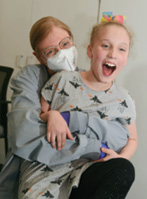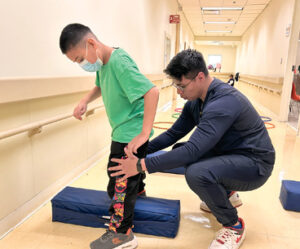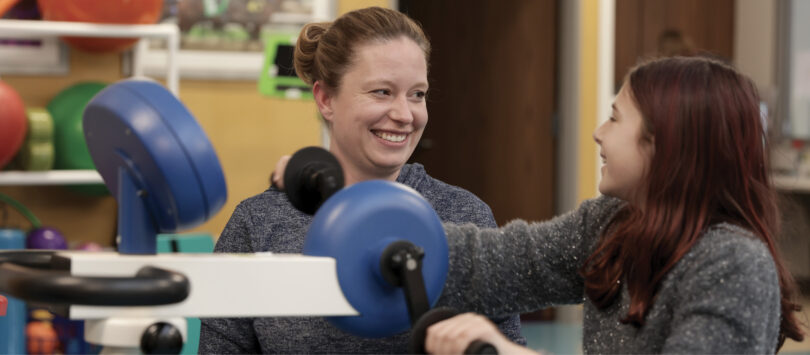“We have been everywhere for therapy, and Shriners Children’s is the best in the world. Luciana’s therapist, Jennifer, is the first person we have made progress with; Luciana is thriving,” said Stacy, mother of Shriners Children’s Lexington patient Luciana.
Luciana has cerebral palsy and a related genetic disorder. For the past three years, mother and daughter have been coming to the clinic weekly.
For patients like Luciana, occupational and physical therapists at Shriners Children’s do more than provide treatment – they change lives. Committed to helping children achieve their fullest potential, these dedicated professionals use innovative, patient-centered approaches to make a difference in their lives.
Path to independence: Therapy in action
Occupational and physical therapy (OT/PT) teams treat a wide range of orthopedic conditions, including scoliosis, sports injuries, developmental delays, sensory processing challenges and postsurgical rehabilitation. They also assist children with splinting, prosthetics, and custom assistive devices like wheelchairs or gait trainers.
Amy Dail, PT, DPT, a physical therapist with 12 years of experience and more than a decade at Shriners Children’s Lexington, explains the distinction between the two therapy fields.
“Physical therapy is more focused on gross motor/mobility-related skills – those bigger movements like walking, running, doing stairs,” said Dail, who manages the rehab department. “Occupational therapy focuses on meaningful daily activities such as bathing, dressing, eating and fine motor skills. Together, we help our patients with all areas of their daily lives.”
Therapists turn hard work into playtime
Working with children takes a special skill set, says Lauren Eckerle, SLP, director of rehabilitation services at Shriners Children’s Chicago. “Every therapy session is a carefully crafted mixture of science, creativity and play,” she said. “Adults in therapy can follow straightforward instructions like, ‘Step side to side with a band around your legs.’ Kids often need a different approach.”
Eckerle manages a team of over 20 physical therapists, occupational therapists and speech-language pathologists who handled more than 17,000 rehab visits last year at the Chicago location. Their practice is growing, with a 9% increase in outpatient rehabilitation in 2024 compared with 2023.
Kids often require engagement, motivation and, most important, fun. “Pediatric therapists are experts in getting kids to do hard things without them realizing it,” explained Eckerle. “You can’t just instruct a younger child to perform an exercise. If you say, ‘You’re stuck in the ocean! The sharks are chasing you! Go! Go!’ the child is moving, laughing and working toward their goals without even realizing it.”
This creative approach is bolstered by an ever-growing assortment of therapy tools – plastic sharks, obstacle courses and themed games. “In pediatric rehab, progress occurs in moments of laughter, adventure and play,” said Eckerle.
A team of specialists with a heart for kids

Luciana, 9, is doing things her mother, Stacy, never thought possible, including gymnastics.
The team at Shriners Children’s Lexington consists of five physical therapists and three occupational therapists, all of whom bring a wealth of expertise to their patients. The team’s collaborative approach ensures that each child receives individualized, holistic treatment. “All of our therapists have a passion for treating children, no matter their specialty or strength,” Dail explained.
As for Luciana, Stacy said her daughter can now do things they never thought possible, including riding a bike and competing in Special Olympics gymnastics. Luciana loves her weekly sessions, including practicing her gymnastics routines for a recent competition in Atlanta.
“I won eight medals,” she said with a smile. “Five were first place!”
Building strength step by step
Sometimes, rehabilitation is about putting one foot in front of the other. At Shriners Children’s Mexico, physical activity is more than just exercise – it’s essential for independence and well-being. The physical therapy team organizes walking groups to help children develop the skills they need for daily life.
Physical therapist Jonás Lugo explained, “We prepare patients for real-world challenges like climbing stairs and walking on uneven surfaces by recreating street structures.”
Many children in the walking group have cerebral palsy, but any child needing to improve balance, coordination or walking mechanics can benefit. “Walking isn’t just about movement,” Lugo noted. “It’s also about balance, coordination and awareness of your surroundings, helping kids feel more secure in daily life.”
To keep sessions engaging, therapists design fun and challenging obstacle courses using cones, hoops, tunnels, mats and balls. “The idea is for kids to exercise while having fun,” Lugo said. This playful approach makes rehabilitation an engaging and positive experience.
Family involvement is a key factor in success. “We encourage parents to replicate the exercises at home,” Lugo added. “When they do, the child’s improvements in strength, speed and rhythm are remarkable.”
Beyond therapy, the walking groups foster friendships between patients and therapists. “They exercise together, celebrate accomplishments and form a special community,” Lugo shared. These sessions create an environment of support, motivation and joy, making rehabilitation a truly transformative journey.
Swallow studies go high-tech
For some families, a child’s ability to eat and swallow safely is a key concern when seeking rehabilitation therapy services. Speech-language pathologists perform comprehensive feeding evaluations for infants and older children. In 2024, Shriners Children’s Chicago expanded its care to include video swallow studies.
These specialized studies utilize a moving X-ray known as fluoroscopy to capture real-time images of how food and liquids of various textures travel through a child’s mouth, throat and esophagus. Swallowing difficulties can occur so quickly in real time that high-quality video review is essential. The hospital has invested in new technology, a TIMS Medical Video Platform™, to deliver diagnostic-quality recordings. This tool instills families with the confidence that feeding or drinking issues in a child are being evaluated using the most advanced technology available.
The study may show whether the child is at risk of aspiration, telling parents and providers whether it is safe for some patients with various neurological and neuromuscular conditions to eat or drink by mouth. A rehabilitation physician and therapist carefully observe the process and, after reviewing it, can better identify any challenges and determine strategies to support the child’s feeding and nutrition.
A lasting impact

Physical therapist Jonás Lugo helps patient Cristofer work on strength and balance.
For therapists at Shriners Children’s, the greatest reward is witnessing children achieve goals they once thought were impossible.
“Success is different for every kid and family. What is success for one patient may not be for another, and that is what makes our jobs so engaging,” Dail said. “Seeing a child meet a goal they did not think they could meet is probably the best part – to watch them realize ‘I can do this. I can do hard things.’”
Through expertise, compassion and innovation, Shriners Children’s therapists continue to make a profound difference – one patient at a time.





